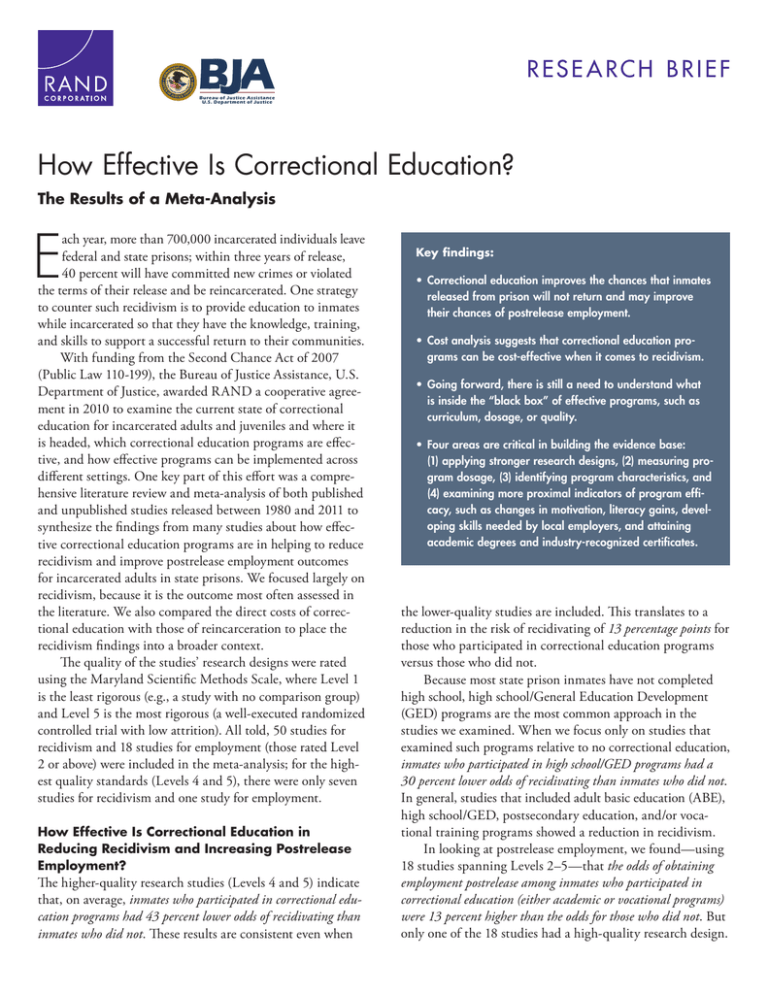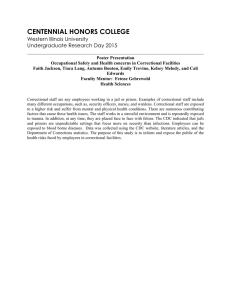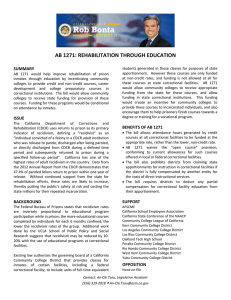E How Effective Is Correctional Education? The Results of a Meta-Analysis
advertisement

Rese arch BRIEF C O R P O R AT I O N Bureau of Justice Assistance U.S. Department of Justice How Effective Is Correctional Education? The Results of a Meta-Analysis E ach year, more than 700,000 incarcerated individuals leave federal and state prisons; within three years of release, 40 percent will have committed new crimes or violated the terms of their release and be reincarcerated. One strategy to counter such recidivism is to provide education to inmates while incarcerated so that they have the knowledge, training, and skills to support a successful return to their communities. With funding from the Second Chance Act of 2007 (Public Law 110-199), the Bureau of Justice Assistance, U.S. Department of Justice, awarded RAND a cooperative agreement in 2010 to examine the current state of correctional education for incarcerated adults and juveniles and where it is headed, which correctional education programs are effective, and how effective programs can be implemented across different settings. One key part of this effort was a comprehensive literature review and meta-analysis of both published and unpublished studies released between 1980 and 2011 to synthesize the findings from many studies about how effective correctional education programs are in helping to reduce recidivism and improve postrelease employment outcomes for incarcerated adults in state prisons. We focused largely on recidivism, because it is the outcome most often assessed in the literature. We also compared the direct costs of correctional education with those of reincarceration to place the recidivism findings into a broader context. The quality of the studies’ research designs were rated using the Maryland Scientific Methods Scale, where Level 1 is the least rigorous (e.g., a study with no comparison group) and Level 5 is the most rigorous (a well-executed randomized controlled trial with low attrition). All told, 50 studies for recidivism and 18 studies for employment (those rated Level 2 or above) were included in the meta-analysis; for the highest quality standards (Levels 4 and 5), there were only seven studies for recidivism and one study for employment. How Effective Is Correctional Education in Reducing Recidivism and Increasing Postrelease Employment? The higher-quality research studies (Levels 4 and 5) indicate that, on average, inmates who participated in correctional education programs had 43 percent lower odds of recidivating than inmates who did not. These results are consistent even when Key findings: • Correctional education improves the chances that inmates released from prison will not return and may improve their chances of postrelease employment. • Cost analysis suggests that correctional education programs can be cost-effective when it comes to recidivism. • Going forward, there is still a need to understand what is inside the “black box” of effective programs, such as curriculum, dosage, or quality. • Four areas are critical in building the evidence base: (1) applying stronger research designs, (2) measuring program dosage, (3) identifying program characteristics, and (4) examining more proximal indicators of program efficacy, such as changes in motivation, literacy gains, developing skills needed by local employers, and attaining academic degrees and industry-recognized certificates. the lower-quality studies are included. This translates to a reduction in the risk of recidivating of 13 percentage points for those who participated in correctional education programs versus those who did not. Because most state prison inmates have not completed high school, high school/General Education Development (GED) programs are the most common approach in the studies we examined. When we focus only on studies that examined such programs relative to no correctional education, inmates who participated in high school/GED programs had a 30 percent lower odds of recidivating than inmates who did not. In general, studies that included adult basic education (ABE), high school/GED, postsecondary education, and/or vocational training programs showed a reduction in recidivism. In looking at postrelease employment, we found—using 18 studies spanning Levels 2–5—that the odds of obtaining employment postrelease among inmates who participated in correctional education (either academic or vocational programs) were 13 percent higher than the odds for those who did not. But only one of the 18 studies had a high-quality research design. One might expect vocational training programs to be more adept than academic education programs at imparting labor market skills, awarding industry-recognized credentials, or connecting individuals with prospective employers. And, indeed, individuals who participated in vocational training programs had odds of obtaining postrelease employment that were 28 percent higher than individuals who had not participated in such programs. Is Correctional Education Cost-Effective? Although correctional education is effective, is it cost-effective? Focusing on recidivism and using a hypothetical pool of 100 inmates, the direct costs of correctional education programs and of incarceration itself, and a three-year reincarceration rate, we estimate that the direct costs of providing education to inmates range from $140,000 to $174,400 for the 100 inmates (or $1,400 to $1,744 per inmate). The three-year reincarceration costs for those who did not receive correctional education are between $2.94 million and $3.25 million, versus $2.07 million and $2.28 million for those who did. Reincarceration costs are thus $870,000 to $970,000 less for those who receive correctional education. Thus, the direct costs of providing correctional education are cost-effective compared with the direct costs of reincarceration. Because the analysis accounts only for direct costs and not for such things as the financial and emotional costs to crime victims and costs to the criminal justice system as a whole, this is a conservative estimate of the broader effect correctional education could yield. What Are the Implications Going Forward? Our study shows that correctional education improves the chances that inmates released from prison will not return to prison and may improve released inmates’ chances of postrelease employment. Our findings are consistent, regardless of whether we restrict our analysis to only the higherquality studies or include studies across the spectrum of research design quality. Further, our cost analysis suggests that correctional education programs can be highly costeffective when it comes to recidivism. And compared with other types of rehabilitative services provided within prisons, correctional education is an intervention that can affect almost every offender. That said, our analysis highlighted a continuing need to understand what is inside the “black box” of effective programs, such as curriculum, dosage, or quality. To inform policy and funding decisions at the state and federal levels, policymakers need additional information and a better understanding of how these programs work (and of what does not work). Also, the evidence base in this area should continue to be built. One option for building the evidence base is for state and federal policymakers and foundations to invest in welldesigned evaluations of correctional education programs. Also, researchers and program evaluators need to strive to implement rigorous research designs to examine questions related to potential selection bias and program dosage and to also measure more proximal outcomes, such as changes in motivation, literacy gains, developing skills needed by local employers, and attaining academic degrees and industryrecognized certificates. Funding grants and guidelines can help further the field by requiring the use of more rigorous research designs. Such funding would also enable correctional educators to partner with researchers and evaluators to undertake rigorous and comprehensive evaluations of their programs. Last, a study registry of correctional education evaluations that included study details (e.g., information about the program and intervention, the evaluation design, characteristics of the treatment and comparison groups, and outcomes measures used) would help states making strategic decisions on whether and how to recalibrate programs to adjust to changes in funding and changes in the prisoner population. This research brief describes work done by RAND Justice, Infrastructure, Environment and documented in Evaluating the Effectiveness of Correctional Education: A Meta-Analysis of Programs That Provide Education to Incarcerated Adults, by Lois M. Davis, Robert Bozick, Jennifer L. Steele, Jessica Saunders, and Jeremy N. V. Miles, RR-266-BJA, 2013 (available at http://www.rand.org/pubs/research_reports/ RR266.html). The RAND Corporation is a nonprofit research institution that helps improve policy and decisionmaking through research and analysis. RAND’s publications do not necessarily reflect the opinions of its research clients and sponsors. R® is a registered trademark. © RAND 2013 This project was supported by Grant No. 2010-RQ-BX-001 awarded by the Bureau of Justice Assistance to the RAND Corporation. The Bureau of Justice Assistance is a component of the Office of Justice Programs, which also includes the Bureau of Justice Statistics, the National Institute of Justice, the Office of Juvenile Justice and Delinquency Prevention, the Office for Victims of Crime, and the Office of Sex Offender Sentencing, Monitoring, Apprehending, Registering, and Tracking. Points of view or opinions in this document are those of the authors and do not necessarily represent the official position or policies of the U.S. Department of Justice. www.rand.org RB-9728-BJA (2013) CHILDREN AND FAMILIES EDUCATION AND THE ARTS The RAND Corporation is a nonprofit institution that helps improve policy and decisionmaking through research and analysis. ENERGY AND ENVIRONMENT HEALTH AND HEALTH CARE INFRASTRUCTURE AND TRANSPORTATION This electronic document was made available from www.rand.org as a public service of the RAND Corporation. INTERNATIONAL AFFAIRS LAW AND BUSINESS NATIONAL SECURITY POPULATION AND AGING PUBLIC SAFETY SCIENCE AND TECHNOLOGY TERRORISM AND HOMELAND SECURITY Support RAND Browse Reports & Bookstore Make a charitable contribution For More Information Visit RAND at www.rand.org Explore the RAND Corporation View document details Research Brief This product is part of the RAND Corporation research brief series. RAND research briefs present policy-oriented summaries of individual published, peer-reviewed documents or of a body of published work. Limited Electronic Distribution Rights This document and trademark(s) contained herein are protected by law as indicated in a notice appearing later in this work. This electronic representation of RAND intellectual property is provided for noncommercial use only. Unauthorized posting of RAND electronic documents to a non-RAND website is prohibited. RAND electronic documents are protected under copyright law. Permission is required from RAND to reproduce, or reuse in another form, any of our research documents for commercial use. For information on reprint and linking permissions, please see RAND Permissions.




